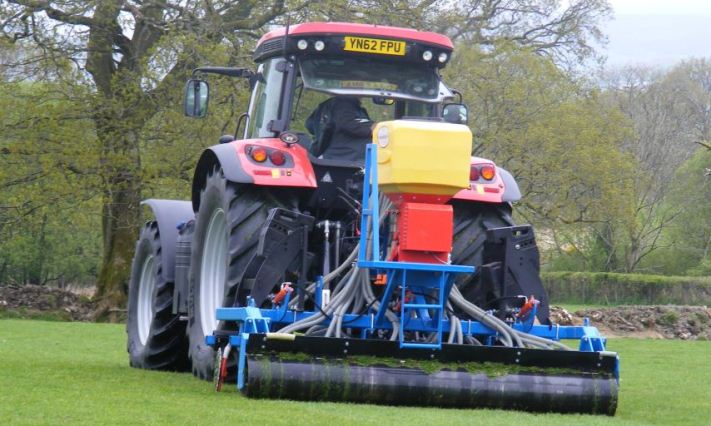Overseeding is an option to boost grassland output
It is not always possible to reseed a sward as it tails off in production and quality, but there are times when overseeding can be just the right approach.
The benefits of improving grassland quality are well known by livestock producers who are keenly aware that grass production and quality can plummet once weed species take hold – even in leys of less than five years old.
For dairy farmers, this diminution in grass output can translate to a massive 48% reduction in the value of milk produced from a given area of grass (see table 1), leaving little doubt of the argument in favour of a reseed.
Table 1: Grassland output calculator
| New | Old | New | Old | |||
| No of cows per ha | 2.5 | 2.5 | Total MJ per ha | 105600 | 85536 | |
| DM yield (tonnes per ha) | 12.0 | 10.8 | MJ for maintenance | 63875 | 63875 | |
| Field loss % | 20.0 | 20.0 | MJ for milk | 41725 | 21661 | |
| ME MJ/kg DM | 11.0 | 9.9 | Max potential milk yield (upper limit 4000l per cow) |
Litres/Ha | 8345 | 4332 |
| MJ/cow/day maintenance | 70 | 70 | Litres/Cow | 3338 | 1733 | |
| MJ/cow/litre milk | 5 | 5 | Milk value/ha £ | 2337 | 1213 | |
| Price per litre £ | 0.28 | 0.28 | Variance £ | -1124 | ||
| Yield gain/loss % | -10% | Output gain/loss % | -48% | |||
A full reseed is not always a practical option, whether due to cash-flow constraints in difficult economic times, stony land which is difficult to cultivate, or simply through the fear of a hiccup in production at a time of high grass demand.
Overseeding could then be considered as a half-way house option, involving around half the financial outlay of a full reseed but still bolstering production and potentially prolonging the life of a ley.
Outlay
Rod Bonshor, general manager of Oliver Seeds, has calculated each cost and says that overseeding requires an outlay of around £211 per hectare compared with £380 for a full reseed (see table 2).
Table 2: Comparison of resseding costs - full reseed or two methods of overseeding
| Reseeding (£/ha) |
Slot seeding (£/ha) |
Overseeding grass harrow (£/ha) |
|
| Desiccation | 35.00 | Weed control 30.00 | Weed control 30.00 |
| Plough and press | 70.00 | ||
| One pass tillage | 69.00 | ||
| Ring rolling (x2) | 35.00 | Grass harrowing (x2) 46.00 | |
| Grass seed with harrow | 29.00 | Cross drilling 79.00 | Seed with harrow 29.00 |
| Ring roll | 17.50 | *17.50 | 17.50 |
| Seed cost | **125.00/35 kilos | **89.00/25 kilos | **89.00/25 kilos |
| Total | 380.50 | 215.50 | 211.50 |
* May be recessary depending on the type of drill. ** Based on similar seed mix.
Source of figures, John Nix Farm Management Pocket Book and NAAC contracting charges, so they could be lower on individual farms.
Either the full reseed or overseeding approach could be appropriate in different situations but in either case, he suggests the trigger point for some form of grassland rejuvenation is when perennial ryegrass in the sward has dropped below 60%.
“Weed control, if necessary, should be done well before any overseeding – the idea being that you populate the gaps where the weeds have died with the desired species,” he says.
Broadcasting the seed and using a grass rake is the slightly cheaper of the two main overseeding options, although Mr Bonshor says that slot seeding, using a drill and making two passes on the straight and diagonal, is generally the more effective approach.

Cheaper still is the use of a fertiliser spinner to broadcast the seed, followed by a pass with a set of chain harrows.
Whatever option is chosen it’s important to get good seed-to-soil contact and both a light slurry application and a pass with Cambridge (rib) rollers will assist in this process.
“Grazing immediately after overseeding is another approach to improving the seed-to-soil contact as the stock will tread in the seed,” he says. “However, it’s important to move them off before the new seedlings come through – usually within two to three weeks – and keep them off for a month to six weeks to give the new grass a chance.”
The choice of seed is an important consideration and the rule of thumb is to select vigorous, large-seeded species of grass.
“This means choosing hybrid perennial ryegrasses and avoiding the less vigorous species such as Timothy or Cocksfoot,” he says.
However, if you are only aiming to prolong the life of your sward by one extra year, he suggests you could consider the fastest growing options such as Westerwolds or Italian ryegrass.
Clover
Alternatively, clover could be considered if protein production needs a boost and white clovers in particular compete well with an established sward.
Important for good establishment is minimal grass coverage, and Mr Bonshor suggests overseeding can work well immediately after first or second cut silage.
“However, autumn is also a good time, and it is nature’s time, although I’d say the cut-off for clover is August as it likes a warm seedbed,” he says.
Try to overseed when soils are high in moisture, which has been most of the time to date this year.”
Viewing overseeding more as a form of repair, he says it can be the right choice when you just want to make a tired ley last another year.
This article first appeared in DAIRY FARMER June 2016
